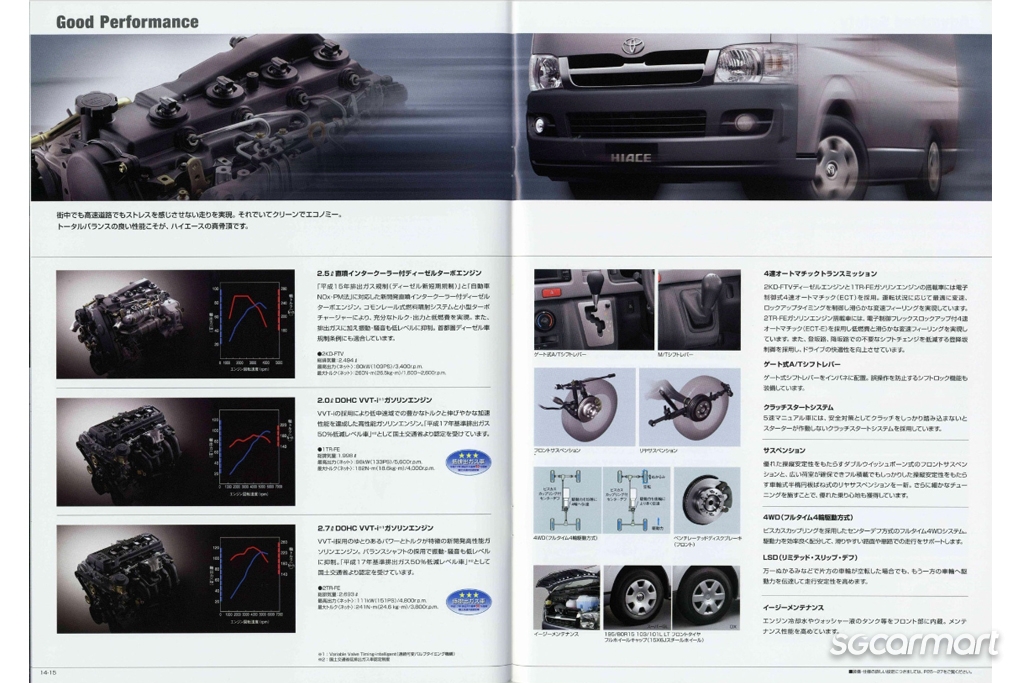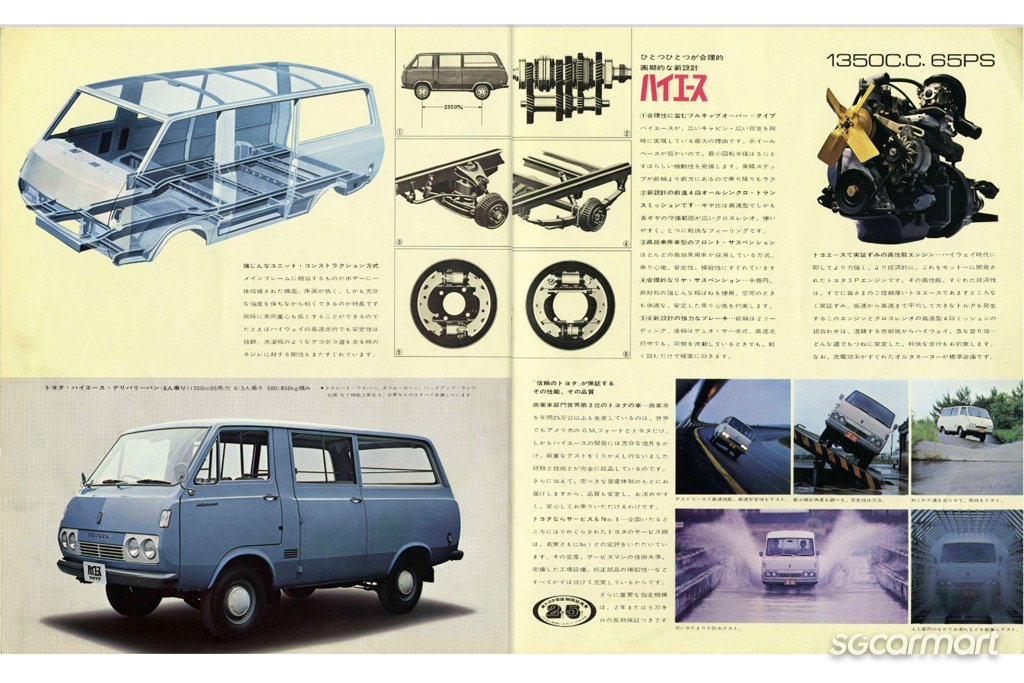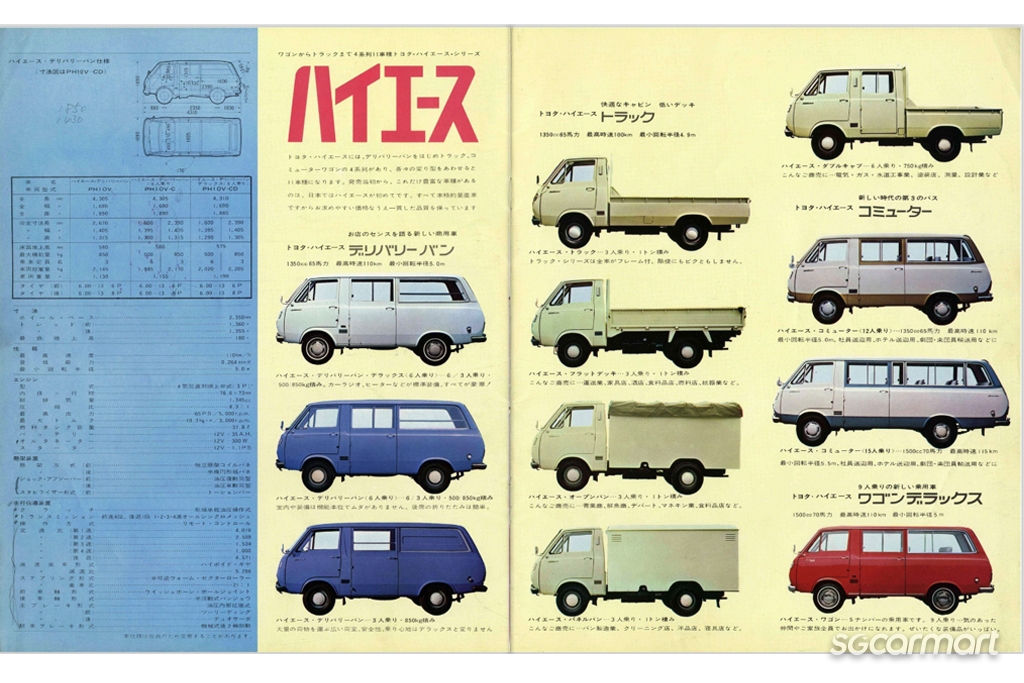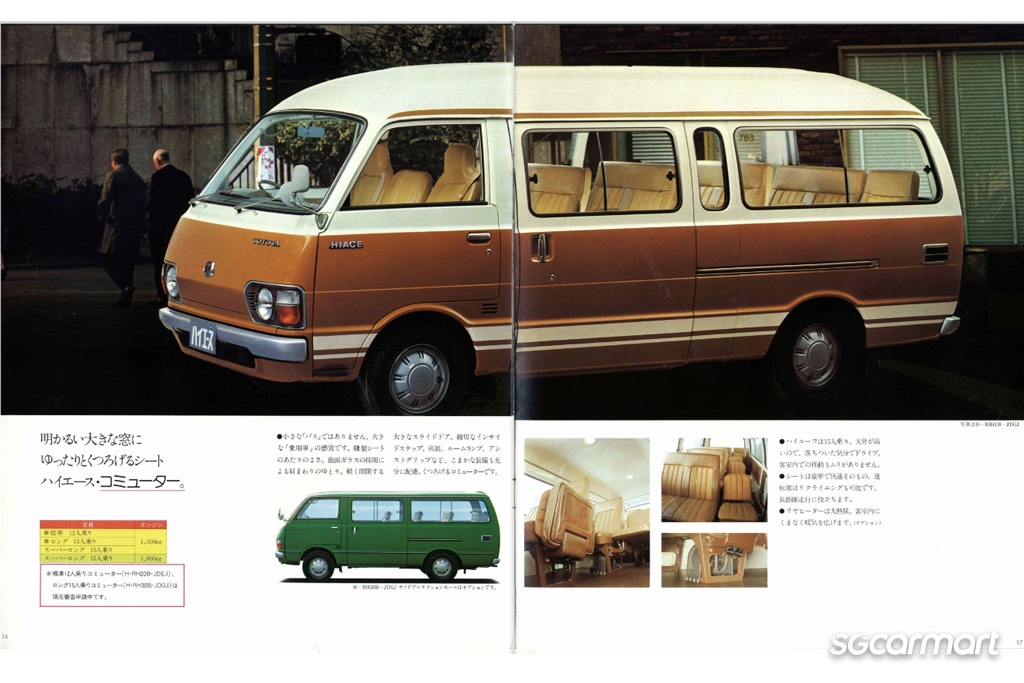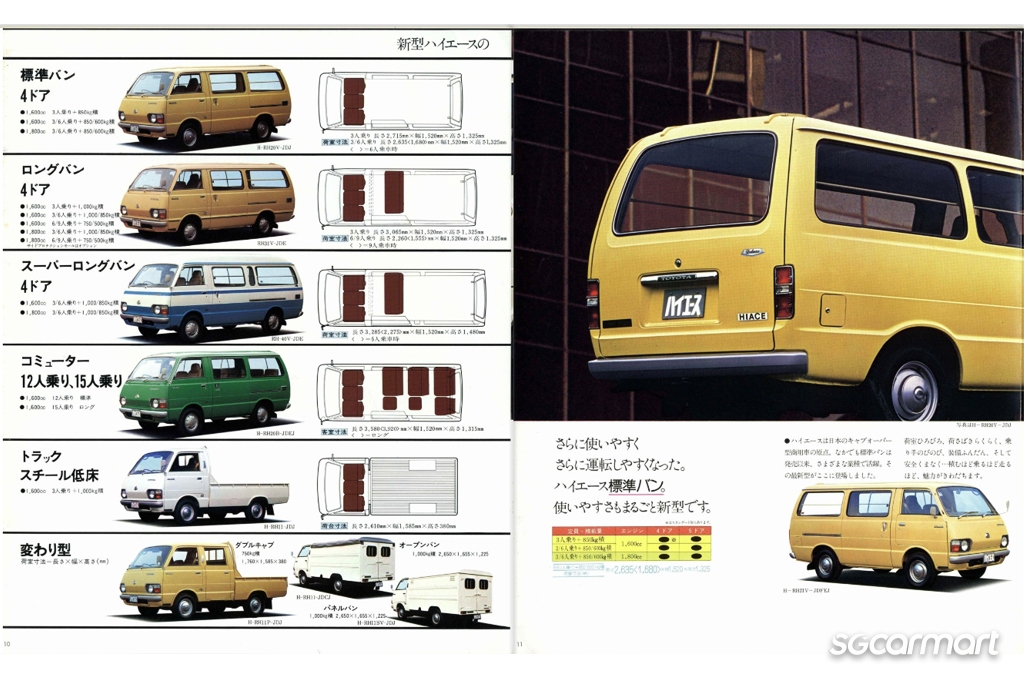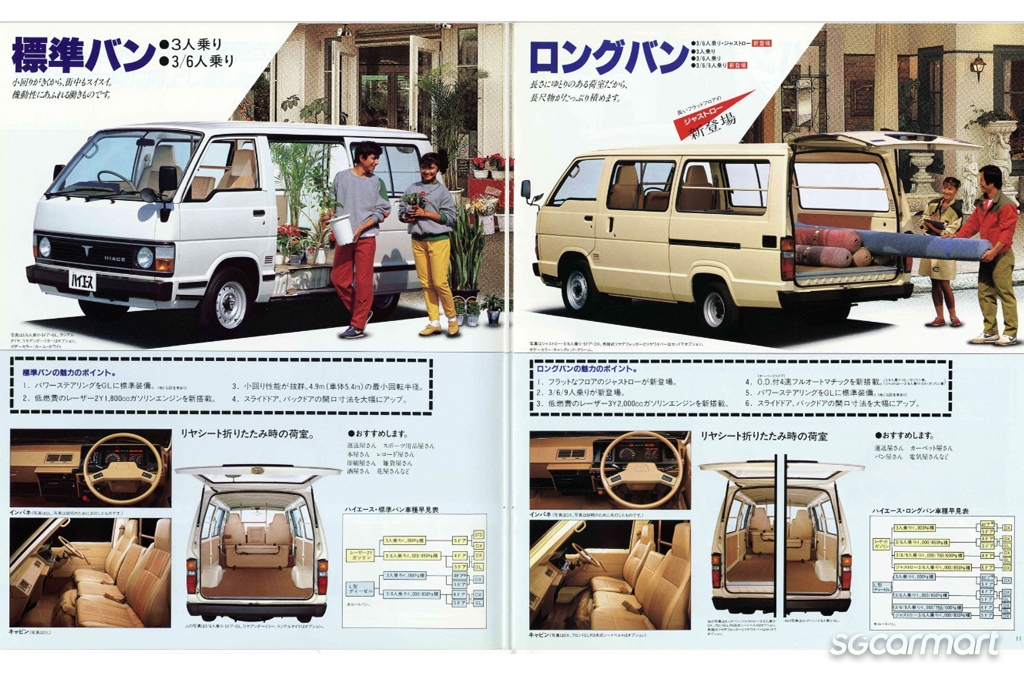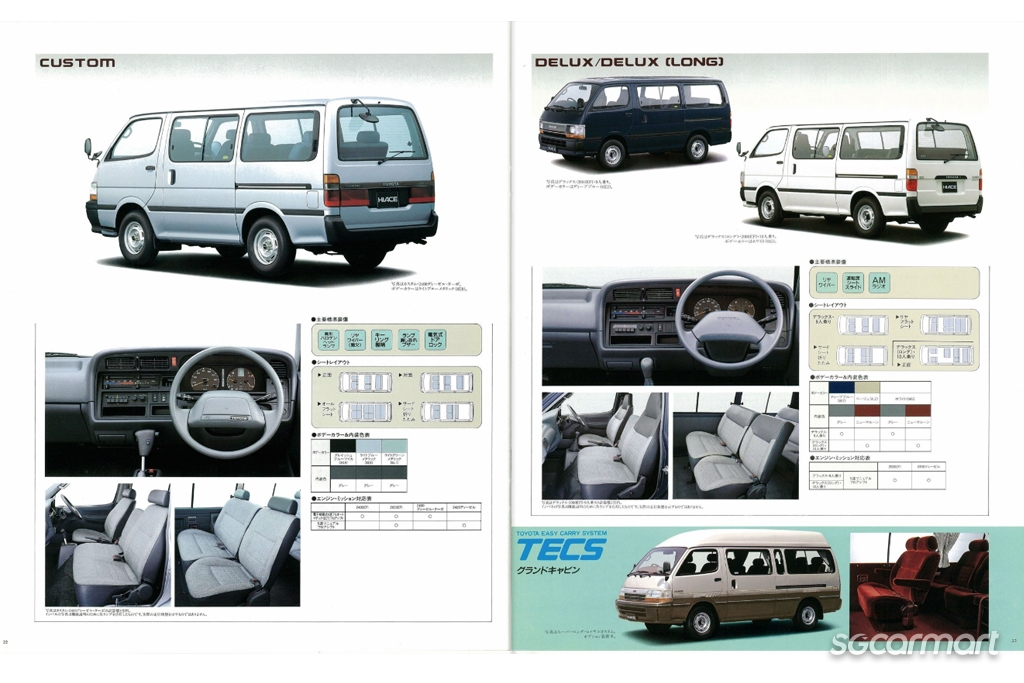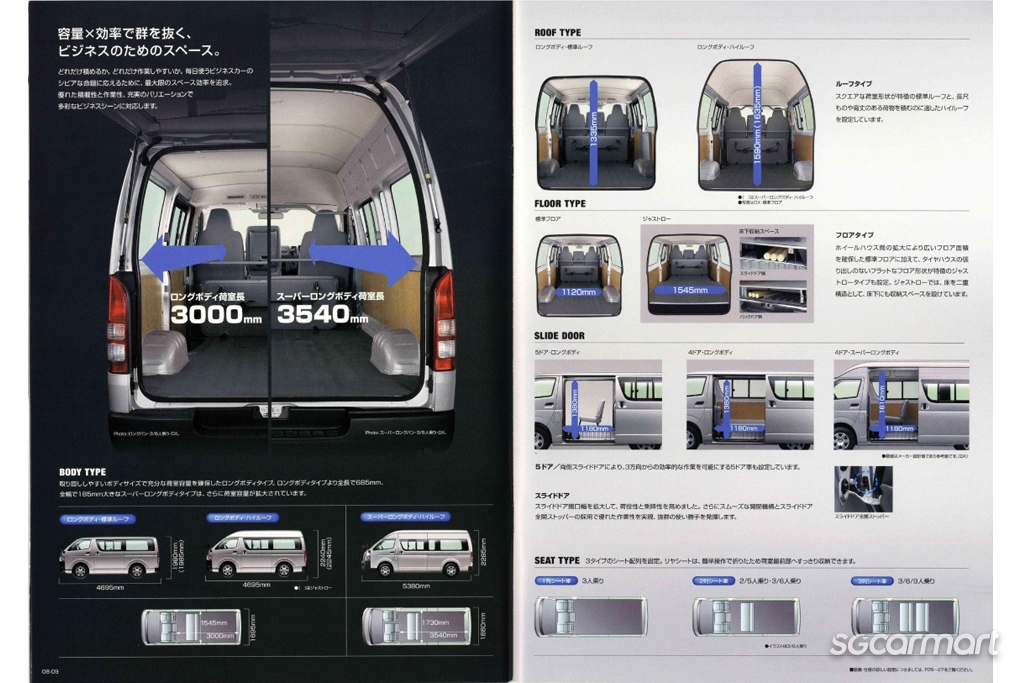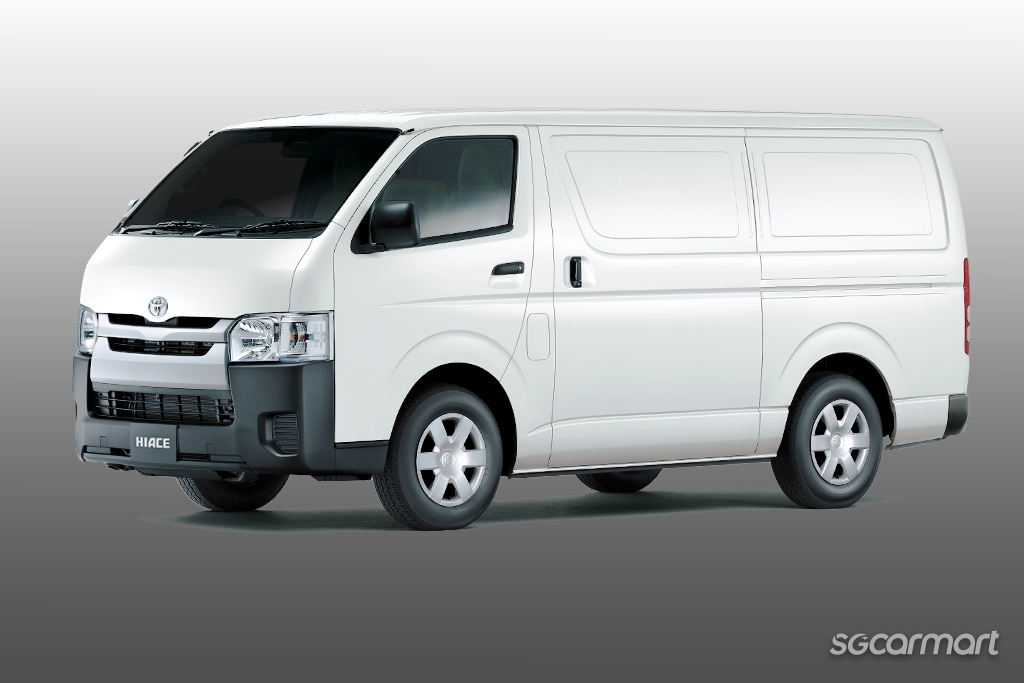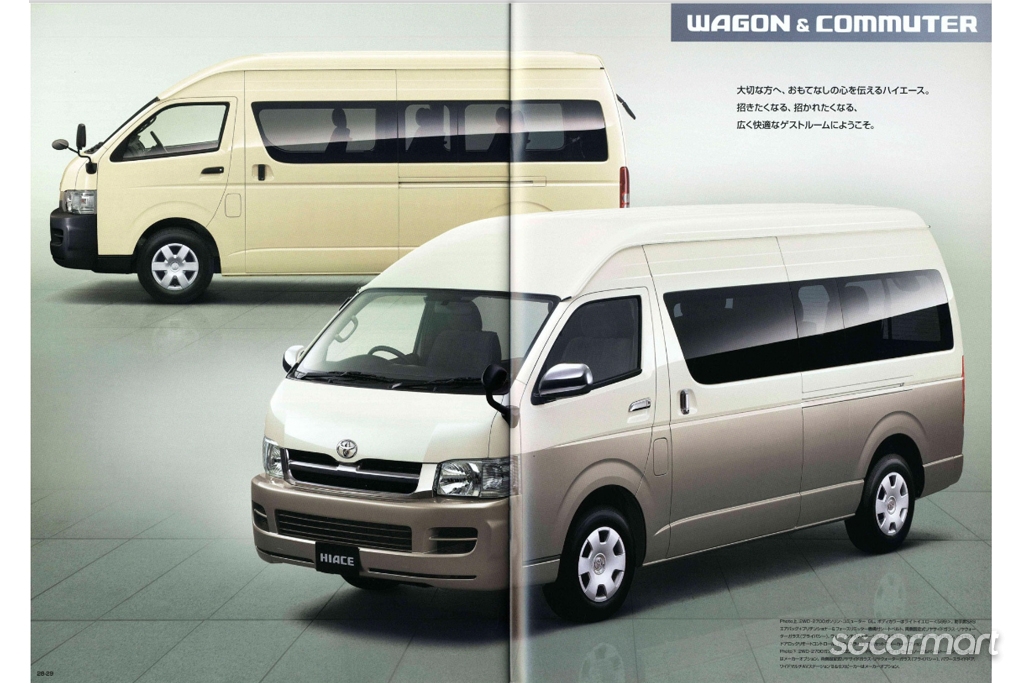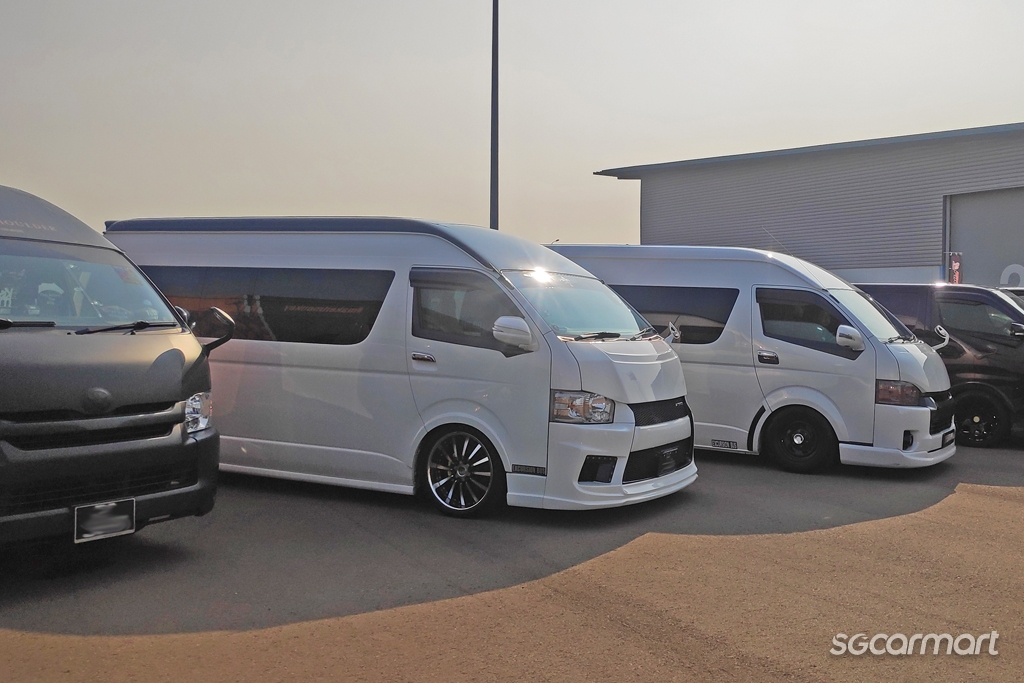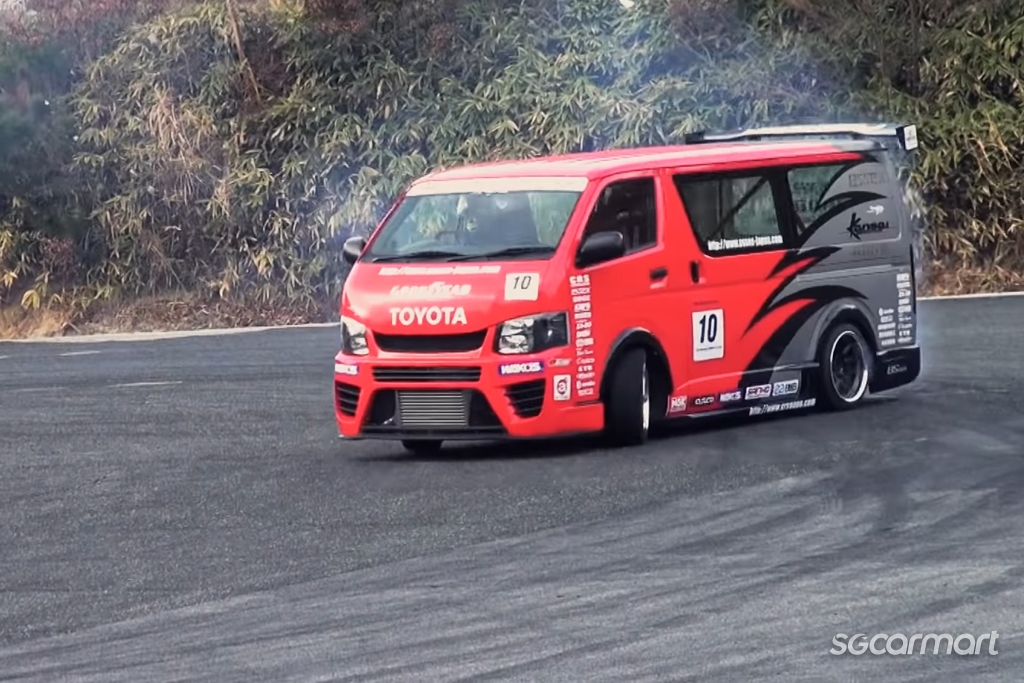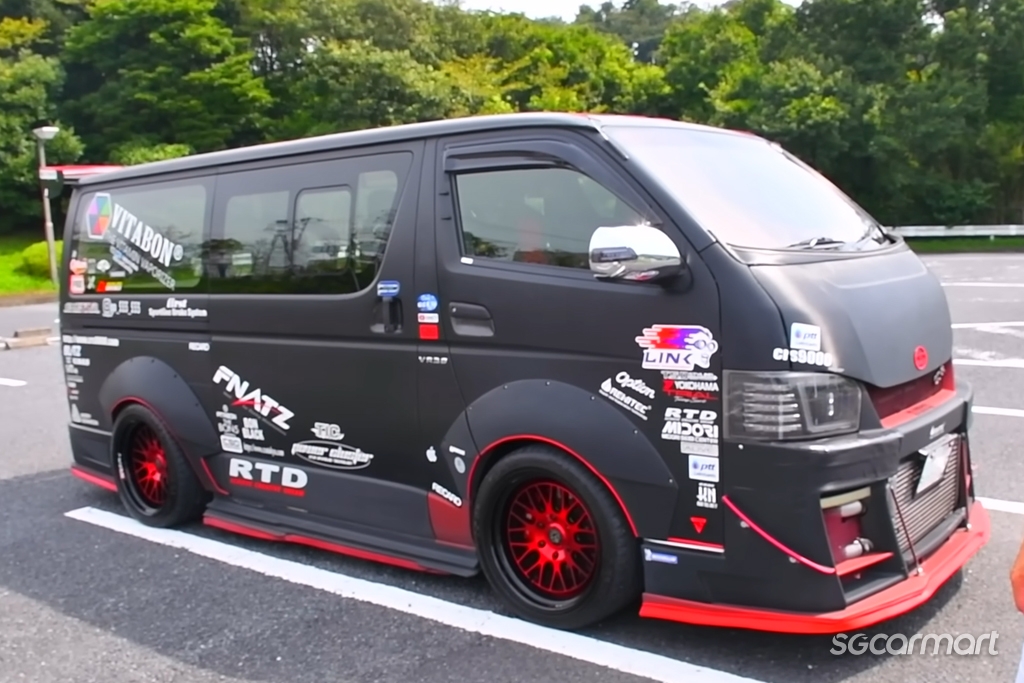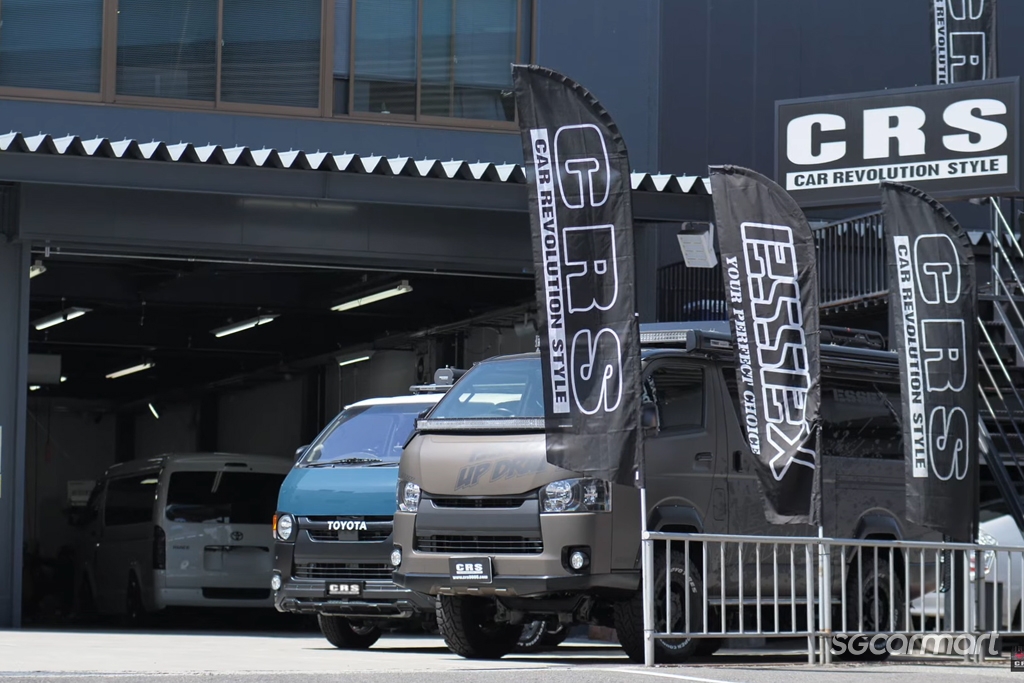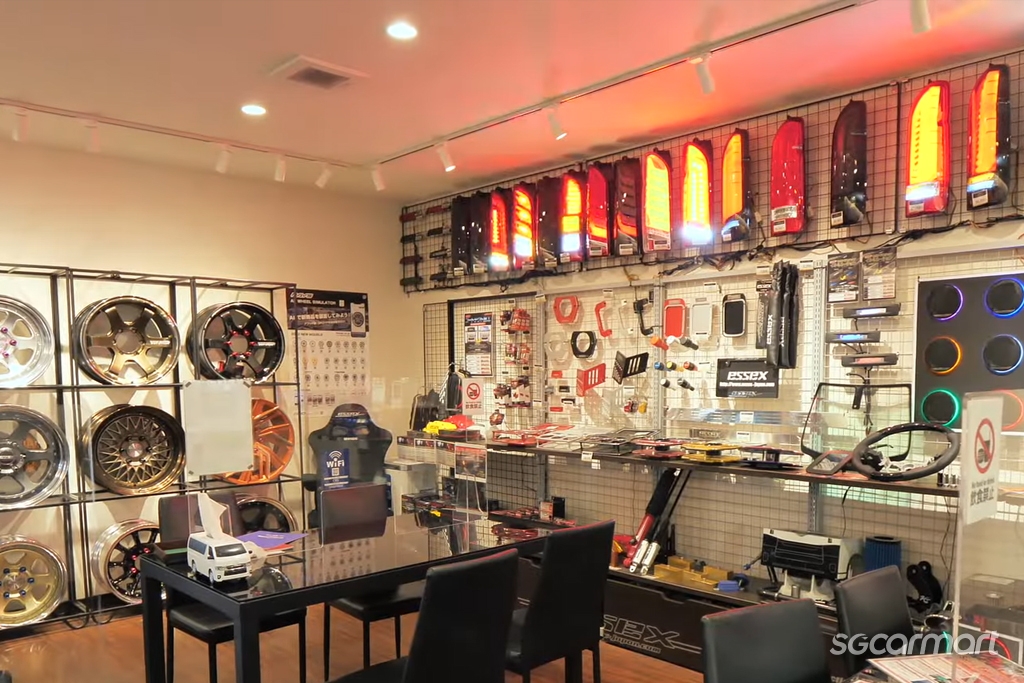Motoring Icons: Commercial Heroes - Toyota Hiace H200
02 Dec 2023|8,322 views
I've written about JDM icons such as the Nissan Skyline, the street legal homologation special of race cars like the BMW M3, and today I've decided to home in on something much more plebeian - the Toyota Hiace van that you'll see every single day on Singapore's roads.
Pronounced as 'high-ace', this venerable Toyota van is available in passenger-hauling minibus and cargo-hauling panel van configurations. On top of these, there are several variants including a short-wheelbase, long-wheelbase, and high roof versions. As a result, no matter what your business is, there is likely a Hiace that would be suited for it.
Thus, it isn't difficult to see why there are simply so many of these on the roads here. Now let's take a closer look at the van that's adored by so many.
Powertrain
Engine variants:
- 1TR-FE 1,998cc in-line four Twin-Cam Naturally Aspirated Petrol - 134bhp at 5,600rpm, 182Nm at 4,000rpm
- 2TR-FE 2,693cc in-line four Twin-Cam Naturally Aspirated Petrol - 158bhp at 5,200rpm, 246Nm at 3,800rpm
- 2KD-FTV 2,494cc in-line four common rail D-4D Turbocharged Diesel - 101bhp-143bhp at 4,300rpm, 148Nm-260Nm at 1,600-2,400/3,600rpm
- 1GD-FTV 2,755cc in-line four common rail D-4D Turbocharged Diesel - 148bhp at 3,400rpm, 300Nm at 1,000-3,400rpm
- 1KD-FTV 2,982cc in-line four common rail D-4D Turbocharged Diesel - 170bhp at 3,400rpm, 343-410Nm at 1,800-3,400rpm
Drivetrain layout: Front-engine, rear-wheel drive
History of the Toyota Hiace H200
While the Hiace that I am looking into today is the fifth generation Hiace (H200), the Toyota Hiace actually has a long history, dating back to 1967 with the first generation H10. Introduced as the successor to the Toyoace, the original Hiace was available in four body types - a delivery van, wagon, commuter and pick-up truck. It is also available in standard and long wheelbase versions, and later in 1974, a high floor and a double cab version were also added to the truck variation.
With the second generation, the Hiace grew in size to offer larger cargo capacity, along with significant improvements in comfort and safety
The second generation Hiace was released in 1977 with significant improvements in functionality, ride comfort and safety, along with a larger floor area and cargo capacity. Like the later Hiace, the second generation Hiace was also offered in various wheelbase and roof variants. At this juncture, all engine options were petrol-powered.
The third generation Hiace might be something that you have seen before, and for the first time, the Hiace is now offered with diesel engine options
Released in 1982, the third generation Hiace might be a model that you have seen on Singapore's road. Not only did this Hiace feature newly developed petrol engines, it was also available with diesel options as well. There was even a top-end Super Custom Limited 7-seater wagon offered along with all-wheel drive models.
The fourth generation was one of the most popular commercial vehicles on Singapore's roads - don't they look familiar to you?
The 1989 fourth generation Hiace is the one that used to ply the roads here. Plenty of them were used as school buses, while the panel vans were popular for commercial use and as delivery vans. This generation Hiace was also used in various countries as ambulances due to its size and reliability. However, as commercial vehicles in Singapore are all limited to a maximum lifespan of 20 years, the only ones left on our roads are those registered as private vehicles.
Introduced 15 years after its predecessor, the fifth generation Hiace has gotten a substantial update - along with its new looks, it also offers even more space and practicality
Finally, decades of evolution resulted in the fifth generation Toyota Hiace (H200) that was introduced in 2004. With a massive gap of 15 years, this new Hiace got a vastly different and modernised design. Throughout all generations, the Hiace vans were able to offer large useable cargo space along with reliability, and they were also available in various configurations. Expectedly, the H200 gets all-round improvements to become even more practical and dependable than its predecessors. The versatility that these vans offered made them truly popular for commercial use in Singapore.
Allure - Cargo van, MPV, minibus, the Hiace does it all
The fifth generation Hiace is likely to be the most common van of its size on the roads in Singapore and there are many reasons why. For one, the Toyota brand has always been associated with reliability and affordability - you can ask anyone for a car recommendation, and I bet Toyota will be one of the brands brought up.
The Hiace (H200) is offered here in a myriad of variants, configurations, and engine options by both the Authorised Dealer and the Parallel Importers. The typical Hiace that you can find on Singapore roads include the panel vans and the Hiace Commuter minibus that has a high-roof body variant. The versatility that it offers means that whether you are a school bus operator, a logistics company or just a small business owner looking for a practical vehicle that does it all, there will be a Hiace that suits your application.
With a range of petrol and turbocharged diesel engines available, potential buyers can choose the type that suits their usage. While the diesel-powered options will incur a higher road tax, the better fuel economy and the lower cost of diesel make it the better choice for those who will be clocking a lot of mileage, such as delivery drivers.
Cultural significance - The Hiace isn't just a boring delivery van!
One interesting aspect of the Hiace community is simply how well-loved this van is. One might assume that a utilitarian commercial vehicle wouldn't have much of a community, but the fact is that there are plenty of Hiace enthusiasts around the world.
Naturally, the Hiace has quite a following in Japan, and being a front-engine, rear-wheel drive platform, there are even people who drift their Hiace vans. If you were to do a quick search online, you'll see a few examples of heavily modified Hiace that look more like purpose-built race cars than a cargo delivery van - there is even a famous example that has a Nissan GT-R engine shoved into it!
Naturally, with a large community of enthusiasts, there is also plenty of demand for modification parts for these vans. As a result, there are countless manufacturers that are making parts to beautify and increase the performance of your Hiace vans. One such company that specialises on modifying Hiaces is Essex CRS Japan - it offers everything, from fancy bodykits, custom LED lighting, suspension components, to interior pieces, rims and many more. Famous Japanese aftermarket brand HKS even has a Blow-Off Valve that is specially designed for the turbocharged diesel Hiace vans!
If you have been attending car meets, you might have noticed that there are a variety of modified Hiace vans in Singapore as well. Some of these have exquisite bodykits and fancy LED lights, along with upgraded sound systems (that large amount of space within is perfect for high-end In-Car Entertainment setups), while there are others that have a custom-built luxurious lounge-like interiors, and then there are some that are lowered with sporty body kit and wheels.
The thing is, the Hiace is just so versatile. Not only are there different body styles and engines, but even when you decide to personalise yours, there are plenty of options available for you to create something that is truly unique. Hence, it isn't difficult to see why these vans get so much love.
Want a Hiace? Sure!
If you want to buy a Hiace, there are plenty of options available - you can still get it brand new if desired, and there are many used ones on the market as well. That said, most of these are registered as commercial vehicles, so you will need to have an incorporated company to register the vehicle to. And if you want to drive to Malaysia, the process would not be as simple - from my understanding, you will have to apply for a permit from the Malaysia authorities to do so.
Currently, a brand new standard roof diesel Hiace will set you back around $130,000, while used examples are available for various prices depending on the numbers of years of COE left. Though you could get something with a month of COE validity left for just $7,000, you should expect the depreciation for a Hiace to range from $9,000 to $20,000 depending on the variant that you want.
Enjoyed reading about the Toyota Hiace? Here are some other articles that you might be interested in:
Motoring Icons: JDM Legends - Mazda NA MX-5
Motoring Icons: Homologation Specials - Toyota GR Yaris
Motoring Icons: JDM Legends - Honda Civic VTi/SiR (EG6)
I've written about JDM icons such as the Nissan Skyline, the street legal homologation special of race cars like the BMW M3, and today I've decided to home in on something much more plebeian - the Toyota Hiace van that you'll see every single day on Singapore's roads.
Pronounced as 'high-ace', this venerable Toyota van is available in passenger-hauling minibus and cargo-hauling panel van configurations. On top of these, there are several variants including a short-wheelbase, long-wheelbase, and high roof versions. As a result, no matter what your business is, there is likely a Hiace that would be suited for it.
Thus, it isn't difficult to see why there are simply so many of these on the roads here. Now let's take a closer look at the van that's adored by so many.
Powertrain
Engine variants:
- 1TR-FE 1,998cc in-line four Twin-Cam Naturally Aspirated Petrol - 134bhp at 5,600rpm, 182Nm at 4,000rpm
- 2TR-FE 2,693cc in-line four Twin-Cam Naturally Aspirated Petrol - 158bhp at 5,200rpm, 246Nm at 3,800rpm
- 2KD-FTV 2,494cc in-line four common rail D-4D Turbocharged Diesel - 101bhp-143bhp at 4,300rpm, 148Nm-260Nm at 1,600-2,400/3,600rpm
- 1GD-FTV 2,755cc in-line four common rail D-4D Turbocharged Diesel - 148bhp at 3,400rpm, 300Nm at 1,000-3,400rpm
- 1KD-FTV 2,982cc in-line four common rail D-4D Turbocharged Diesel - 170bhp at 3,400rpm, 343-410Nm at 1,800-3,400rpm
Drivetrain layout: Front-engine, rear-wheel drive
History of the Toyota Hiace H200
While the Hiace that I am looking into today is the fifth generation Hiace (H200), the Toyota Hiace actually has a long history, dating back to 1967 with the first generation H10. Introduced as the successor to the Toyoace, the original Hiace was available in four body types - a delivery van, wagon, commuter and pick-up truck. It is also available in standard and long wheelbase versions, and later in 1974, a high floor and a double cab version were also added to the truck variation.
With the second generation, the Hiace grew in size to offer larger cargo capacity, along with significant improvements in comfort and safety
The second generation Hiace was released in 1977 with significant improvements in functionality, ride comfort and safety, along with a larger floor area and cargo capacity. Like the later Hiace, the second generation Hiace was also offered in various wheelbase and roof variants. At this juncture, all engine options were petrol-powered.
The third generation Hiace might be something that you have seen before, and for the first time, the Hiace is now offered with diesel engine options
Released in 1982, the third generation Hiace might be a model that you have seen on Singapore's road. Not only did this Hiace feature newly developed petrol engines, it was also available with diesel options as well. There was even a top-end Super Custom Limited 7-seater wagon offered along with all-wheel drive models.
The fourth generation was one of the most popular commercial vehicles on Singapore's roads - don't they look familiar to you?
The 1989 fourth generation Hiace is the one that used to ply the roads here. Plenty of them were used as school buses, while the panel vans were popular for commercial use and as delivery vans. This generation Hiace was also used in various countries as ambulances due to its size and reliability. However, as commercial vehicles in Singapore are all limited to a maximum lifespan of 20 years, the only ones left on our roads are those registered as private vehicles.
Introduced 15 years after its predecessor, the fifth generation Hiace has gotten a substantial update - along with its new looks, it also offers even more space and practicality
Finally, decades of evolution resulted in the fifth generation Toyota Hiace (H200) that was introduced in 2004. With a massive gap of 15 years, this new Hiace got a vastly different and modernised design. Throughout all generations, the Hiace vans were able to offer large useable cargo space along with reliability, and they were also available in various configurations. Expectedly, the H200 gets all-round improvements to become even more practical and dependable than its predecessors. The versatility that these vans offered made them truly popular for commercial use in Singapore.
Allure - Cargo van, MPV, minibus, the Hiace does it all
The fifth generation Hiace is likely to be the most common van of its size on the roads in Singapore and there are many reasons why. For one, the Toyota brand has always been associated with reliability and affordability - you can ask anyone for a car recommendation, and I bet Toyota will be one of the brands brought up.
The Hiace (H200) is offered here in a myriad of variants, configurations, and engine options by both the Authorised Dealer and the Parallel Importers. The typical Hiace that you can find on Singapore roads include the panel vans and the Hiace Commuter minibus that has a high-roof body variant. The versatility that it offers means that whether you are a school bus operator, a logistics company or just a small business owner looking for a practical vehicle that does it all, there will be a Hiace that suits your application.
With a range of petrol and turbocharged diesel engines available, potential buyers can choose the type that suits their usage. While the diesel-powered options will incur a higher road tax, the better fuel economy and the lower cost of diesel make it the better choice for those who will be clocking a lot of mileage, such as delivery drivers.
Cultural significance - The Hiace isn't just a boring delivery van!
One interesting aspect of the Hiace community is simply how well-loved this van is. One might assume that a utilitarian commercial vehicle wouldn't have much of a community, but the fact is that there are plenty of Hiace enthusiasts around the world.
Naturally, the Hiace has quite a following in Japan, and being a front-engine, rear-wheel drive platform, there are even people who drift their Hiace vans. If you were to do a quick search online, you'll see a few examples of heavily modified Hiace that look more like purpose-built race cars than a cargo delivery van - there is even a famous example that has a Nissan GT-R engine shoved into it!
Naturally, with a large community of enthusiasts, there is also plenty of demand for modification parts for these vans. As a result, there are countless manufacturers that are making parts to beautify and increase the performance of your Hiace vans. One such company that specialises on modifying Hiaces is Essex CRS Japan - it offers everything, from fancy bodykits, custom LED lighting, suspension components, to interior pieces, rims and many more. Famous Japanese aftermarket brand HKS even has a Blow-Off Valve that is specially designed for the turbocharged diesel Hiace vans!
If you have been attending car meets, you might have noticed that there are a variety of modified Hiace vans in Singapore as well. Some of these have exquisite bodykits and fancy LED lights, along with upgraded sound systems (that large amount of space within is perfect for high-end In-Car Entertainment setups), while there are others that have a custom-built luxurious lounge-like interiors, and then there are some that are lowered with sporty body kit and wheels.
The thing is, the Hiace is just so versatile. Not only are there different body styles and engines, but even when you decide to personalise yours, there are plenty of options available for you to create something that is truly unique. Hence, it isn't difficult to see why these vans get so much love.
Want a Hiace? Sure!
If you want to buy a Hiace, there are plenty of options available - you can still get it brand new if desired, and there are many used ones on the market as well. That said, most of these are registered as commercial vehicles, so you will need to have an incorporated company to register the vehicle to. And if you want to drive to Malaysia, the process would not be as simple - from my understanding, you will have to apply for a permit from the Malaysia authorities to do so.
Currently, a brand new standard roof diesel Hiace will set you back around $130,000, while used examples are available for various prices depending on the numbers of years of COE left. Though you could get something with a month of COE validity left for just $7,000, you should expect the depreciation for a Hiace to range from $9,000 to $20,000 depending on the variant that you want.
Enjoyed reading about the Toyota Hiace? Here are some other articles that you might be interested in:
Motoring Icons: JDM Legends - Mazda NA MX-5
Motoring Icons: Homologation Specials - Toyota GR Yaris
Motoring Icons: JDM Legends - Honda Civic VTi/SiR (EG6)
Thank You For Your Subscription.






















